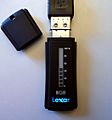Electronic paper facts for kids
Electronic paper, also known as e-paper, is a special type of screen. It looks a lot like regular ink printed on a piece of paper. Unlike computer screens or phone displays, e-paper can show text and images for a very long time without needing any electricity. This makes it super energy-efficient! Some types of e-paper are even flexible, meaning they can bend like a real piece of paper.
Contents
What is Electronic Paper?
Electronic paper is a display technology designed to copy the look of ink on paper. It reflects light, just like real paper, instead of shining light from behind like most screens. This makes it very easy to read, even in bright sunlight. It also means your eyes don't get as tired when you read on an e-paper screen for a long time.
How Does E-Paper Work?
Most e-paper screens use tiny, tiny capsules, smaller than a human hair. Each capsule contains two types of tiny particles:
- White particles that have a positive electrical charge.
- Black particles that have a negative electrical charge.
When an electric field is applied, these particles move up or down. If the white particles move to the top, that spot looks white. If the black particles move to the top, that spot looks black. By controlling where these particles go, e-paper can create letters and pictures. Once the particles are in place, they stay there until the screen needs to change. This is why e-paper uses almost no power when you are just looking at a page. It only uses power when it "refreshes" or changes what is on the screen.
Where is E-Paper Used?
E-paper is used in many different devices because of its unique features:
- E-readers: These are devices like the Amazon Kindle. They are designed to replace paper books. E-readers are very popular because they are light, easy to read for hours, and have very long battery lives.
- Smartwatches: Some smartwatches use e-paper displays. This helps their batteries last much longer than watches with regular color screens.
- Digital signs: You might see e-paper displays on bus stops or train stations. They are great for showing timetables or information because they are easy to read outdoors.
- Electronic shelf labels: In stores, e-paper is used for price tags. It's easy to update prices wirelessly without printing new labels.
- USB drives: Some USB flash drives use a small e-paper screen to show how much storage space is left.
Benefits of E-Paper
E-paper has several cool advantages:
- Easy on the eyes: Because it reflects light like paper, it feels more natural to read. It doesn't have the flicker or glare that can bother your eyes on other screens.
- Long battery life: Since it only uses power when the screen changes, devices with e-paper can last for weeks or even months on a single charge.
- Readable in sunlight: The more light there is, the clearer an e-paper screen becomes. This is the opposite of phone screens, which are hard to see in bright sun.
- Flexible designs: Some e-paper can be made on flexible plastic. This opens up possibilities for screens that can bend or even roll up.
Images for kids
See also
 In Spanish: Tinta electrónica para niños
In Spanish: Tinta electrónica para niños








